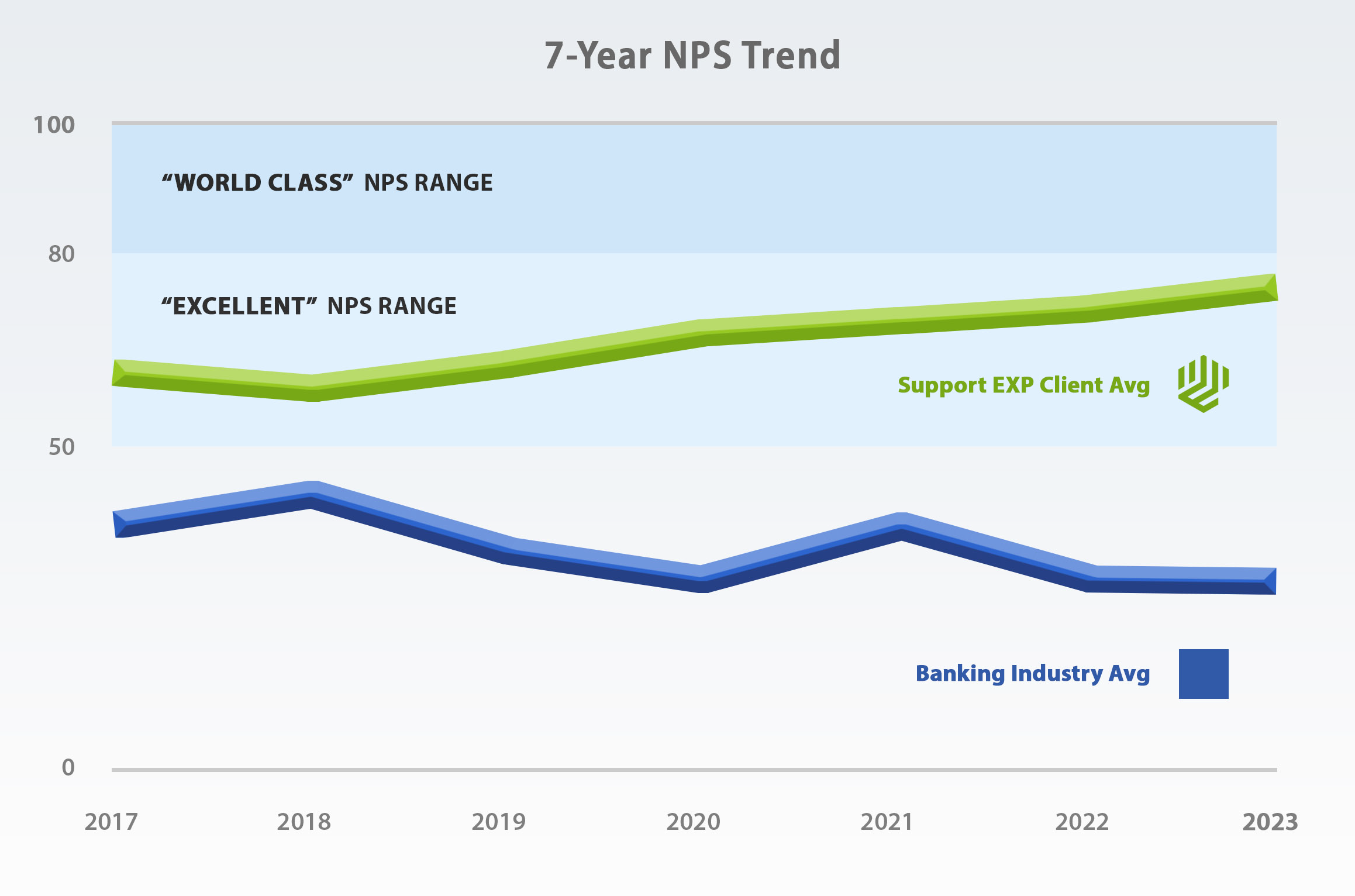How to Improve Your NPS Score – Our Guide for Banks and Credit Unions

Table of Contents
Key Takeaways:
- Consistency in meeting customer expectations boosts NPS by fostering trust and reliability; customers who feel heard and valued through their NPS survey participation are more likely to recommend you.
- The accuracy and usefulness of NPS feedback is dependent in part on the design and implementation of the survey tool, as these factors impact responsiveness and engagement.
- Integration of NPS feedback throughout your organization, from management to frontline teams, is crucial for building a culture aligned to and accountable for the customer experience.
Financial institutions can improve their NPS scores by regularly capturing and acting on customer feedback to improve service, streamline processes, and provide proactive customer support. In demonstrating a commitment to customer satisfaction, banks and credit unions will earn trust and see long-term loyalty rise along with their NPS.
Factors Affecting NPS
Product quality and performance, customer service, survey design and delivery, employee engagement, and external factors are all elements impacting your NPS.
Let’s take a look at the role each of these elements contributes to your customer loyalty and satisfaction.
Product Quality and Performance
Consistency in meeting customer expectations
Consistency in meeting customer expectations significantly impacts NPS by building trust and reliability.
When customers consistently experience the standard of service they expect, their satisfaction increases. This predictability reassures customers that they can depend on you, encouraging repeat business and increasing their willingness to recommend you to others.
But inconsistency in meeting expectations can erode trust and lower NPS, as customers become frustrated by service that doesn’t reach the standard you have set in their mind.
Comparison with industry standards
Comparison with industry standards provides a benchmark for performance and identifies areas for improvement.
When your bank or credit union measures your NPS against industry norms, you gain insight into your competitive standing and customer satisfaction relative to your peers. This comparison highlights both differentiating strengths and opportunities to strengthen your execution.
An above-average NPS can reinforce a positive reputation and engender customer loyalty. But an NPS below the standard can signal the need for strategic changes to improve the customer experience.
Customer Service
Impact of prompt and effective customer service
Prompt and effective customer service directly influences customer satisfaction and loyalty. When customers receive quick and efficient responses to their inquiries or issues, they feel valued and supported.
This positive interaction makes it more likely your customers will recommend you to others.
Effective customer service helps in resolving problems quickly, preventing negative experiences from escalating and damaging your reputation. The satisfied customers that result from such outreach are more inclined to become promoters of your brand.
Importance of addressing customer feedback
Addressing customer feedback demonstrates that your financial institution values your customers’ opinions and is committed to continuous improvement.
By actively listening to feedback, you can address pain points and enhance the customer experience. This responsiveness can turn detractors into promoters, because customers appreciate when their concerns are acknowledged and resolved.
Acting on feedback can lead to innovations that align your product and services more closely with your customers’ needs and expectations.
This proactive approach not only boosts satisfaction and loyalty but positively influences NPS. After all, customers who feel heard and valued are more likely to recommend you.

Survey Design and Delivery
Crafting clear and concise survey questions
To gain accurate and actionable insights, your NPS survey has to use clear and concise questions.
Well-designed questions ensure that respondents fully understand what is being asked, reducing the likelihood of misinterpretation.
Clear questions make it easier for customers to provide honest and thoughtful feedback, while concise questions increase the likelihood of survey completion. Through simplicity and clarity in your NPS survey design, you can gather meaningful data that accurately reflects customer sentiment. Then you will be able to make more informed decisions to enhance customer satisfaction and loyalty.
Optimal timing and frequency of surveys
Optimal timing and frequency of NPS surveys is critical in capturing meaningful and actionable feedback. Conducting surveys too frequently can lead to survey fatigue, causing customers to disengage or provide less thoughtful responses.
The ideal approach is to survey customers at key touchpoints, whether an everyday transaction or a major financial milestone like taking out a mortgage. This timing ensures that feedback is relevant and top-of-mind for the customer.
Relationship surveys conducted periodically, such as quarterly or biannually, can help track changes in customer satisfaction and loyalty over time without overwhelming your customers.
Balancing the frequency and timing of NPS surveys allows you to maintain customer engagement while gathering data to drive improvement.
Choosing the right delivery channels
Choosing the right delivery channels for your NPS surveys helps to maximize response rates and gain representative feedback.
Different customer segments may prefer different communication methods, such as email, SMS, in-app notifications, or even the classic paper survey.
By selecting the channels that align with your customers’ preferences and behaviors, you enhance the survey’s convenience and accessibility, encouraging more customers to participate. Effective delivery channels contribute to a seamless survey experience, making it easier for customers to share their opinions.
Employee Engagement
Role of motivated staff in delivering exceptional service
Motivated employees play a central role in delivering exceptional service, as they directly influence customer satisfaction and loyalty.
Engaged employees are more likely to go “above and beyond” in their interactions with customers, providing attentive, personalized, and efficient service.
Positive attitude and commitment create memorable customer experiences that elevate your NPS. Motivated employees are also more likely to take ownership of resolution of customer issues, contributing to both efficiency and accountability.
Training and empowering employees based on NPS feedback
Training and empowerment of employees based on NPS feedback is a driver of continuous improvement and differentiating customer experiences.
NPS feedback provides valuable insights into customer perceptions, highlighting areas where employees excel and where they can improve. By integrating this feedback into training programs, banks and credit unions can address specific gaps in skills and knowledge, equipping employees with the tools they need to better meet customer expectations.
Empowering employees with this knowledge gives them a sense of ownership and accountability, encouraging them to take proactive steps to enhance service quality. When employees see how their efforts directly impact customer satisfaction and NPS scores, it boosts their motivation and engagement.
External Factors
Influence of market trends and competitive landscape
Market trends and the competitive landscape significantly influence NPS by shaping customer expectations and perceptions.
As industries evolve and new trends emerge, customers’ standards for products and services shift, often raising the bar for their satisfaction. Businesses must stay attuned to these trends to remain competitive and meet customer expectations.
Customers frequently compare their experiences with you to experiences they have with other businesses. If competitors offer superior products, services, or innovations, it can negatively impact your NPS.
Staying ahead of market trends and understanding the competitive landscape allows you to intercept trends, ensuring you deliver products and experiences that earn customer loyalty and drive higher NPS.
Adapting to economic conditions and consumer behavior shifts
Maintaining and improving NPS requires adapting to economic conditions and shifts in consumer behavior, as these changes can directly impact how customers perceive your value and service quality.
During economic downturns, for example, customers may become more price-sensitive and expect greater value, influencing their likelihood to recommend a company. Similarly, shifts in consumer behavior, such as the increasing preference for online shopping or sustainability-conscious purchasing decisions, require businesses to adjust their strategies and offerings accordingly.
By adapting proactively to such changes, you can align your operations with customer expectations, enhance satisfaction levels, and ultimately improve NPS and your competitive position.

Strategies to Improve NPS
There’s a right way to go about improving your Net Promoter Score. It starts with making sure you are using the right tool to measure the customer experience and get feedback you can act on.
Survey Optimization - Designing Effective Surveys
Asking the right questions for actionable insights
Improving Net Promoter Score (NPS) can turn on asking the right questions to gain actionable insights. Instead of merely inquiring how likely customers are to recommend you, your surveys need to dig deeper into the reasons behind their ratings.
Follow-up NPS questions should explore specific aspects of the customer experience, such as responsiveness, empathy, and ease of use. Open-ended questions can uncover detailed feedback and highlight areas for improvement.
By systematically analyzing this qualitative data, you can identify recurring themes and pain points to act on.
Utilizing cascading questions to gather detailed feedback
Utilizing cascading questions is an effective strategy for gathering detailed customer feedback in an NPS survey.
This technique involves structuring the survey in a way that each subsequent question is determined by the respondent’s previous answer.
For example, if a customer indicates dissatisfaction with a product, follow-up questions can reveal the specific reasons behind their dissatisfaction. This dynamic approach allows for a more personalized and in-depth understanding of customer experiences, as it tailors the survey path to individual responses.
Increasing Response Rates
Clear communication of survey purpose and time commitment
A healthy survey response rate can depend on clear communication of a survey’s purpose and the respondent’s time commitment.
When customers understand why their feedback is valuable and how it will be used, they are more likely to feel that their participation is meaningful.
Clearly stating the survey’s expected duration or length helps manage time expectations, reducing reluctance to start the survey. Transparency about the purpose and time commitment builds trust and encourages participation, as respondents appreciate knowing that their input will lead to tangible improvements.
Higher engagement and completion rates mean richer and more reliable data for you to act on.
Monitoring and updating contact lists
Updated contact lists are central to adequate survey response rates. Accurate and up-to-date contact information ensures that surveys reach the intended recipients, minimizing bounce rates and undelivered messages.
Regularly cleaning and segmenting contact lists allows you to tailor your outreach so you can send relevant surveys to the right audience segments, increasing the likelihood of engagement. Removal of duplicates and inactive addresses streamlines the survey process and reduces waste.
With a well-managed contact list, a bank or credit union can communicate better, enhance survey relevance, and ultimately boost response rates.
Timing surveys to coincide with key customer touchpoints
Timing surveys to coincide with key customer touchpoints can significantly increase response rates.
By aligning survey distribution with moments when customers are most engaged, such as immediately after a customer service interaction, opening an account, or applying for a loan, financial institutions capture feedback when the experience is fresh in the customer’s mind.
This immediacy increases the accuracy and relevance of responses. Well-timed surveys are also less likely to be perceived as intrusive, being integrated naturally into the customer journey.
Targeting the Right Audience
Segmenting surveys based on customer demographics and behavior
Segmenting NPS surveys based on customer demographics and behavior can yield more targeted and actionable insights.
By categorizing respondents according to factors such as age, gender, location, purchase history, and engagement patterns, you can tailor questions to address specific experiences and expectations unique to each segment.
This approach allows for a more nuanced understanding of different customer groups, highlighting distinct drivers and pain points. For instance, younger customers might prioritize digital experience, while older customers might value personalized service more.
This targeted segmentation enhances the relevance of the feedback collected, leading to more effective and precise improvements.
Tailoring questions to specific customer segments
More meaningful insights are the likely outcome of customizing survey questions to address the unique experiences and expectations of different customer groups.
For example, a segment of tenured customers might receive questions about loyalty and long-term satisfaction, while new customers could be asked about their initial impressions and onboarding experience.
A targeted approach ensures that feedback is specific and actionable, leading to more precise improvements and fostering loyalty across all segments.

Engaging with Customers
NPS feedback can alert you to customer dissatisfaction, as well as inform your follow-up communications. Read on to discover how to build a culture of accountability for your CX performance.
Closing the Loop
Acting on feedback from detractors promptly
Acting promptly on feedback from detractors can significantly improve NPS by addressing issues before they escalate. Responding quickly to negative feedback gives you the opportunity to mitigate dissatisfaction and turn detractors into promoters.
Implementing changes based on detractor feedback can lead to immediate improvements in product or service quality. Additionally, responsiveness can prompt positive word-of-mouth and rebuild trust with customers.
Engaging with passives to uncover underlying concerns
Engaging with passives from NPS surveys can help to uncover issues that might be preventing them from becoming promoters.
Passives, who rate their experience as average, often have valuable insights into subtle issues or areas for improvement that are not as immediately apparent as those highlighted by detractors.
By reaching out to passives with follow-up questions and inviting them to share their thoughts in more detail, you can get clues into the facets of your experience that are keeping them from rating you higher.
This engagement can bridge the gap between passives and promoters by addressing these concerns, encouraging them to become more enthusiastic advocates for your brand.
Proactively Soliciting Feedback
Encouraging customer feedback through multiple channels
Encouraging customer feedback through multiple channels promotes a comprehensive and diverse range of insights into your customer experience.
By providing various platforms for customers to share their opinions, such as email surveys, social media, live chat, phone calls, and in-app feedback forms, you accommodate all preferences. This multi-channel approach ensures that customers can choose the most convenient and comfortable method for them, increasing the likelihood of participation.
Additionally, leveraging multiple channels allows you to gather feedback at different stages of the customer journey. By actively seeking feedback through the entire scope of touchpoints, you can uncover valuable insights, identify trends, and make well-informed decisions that strengthen customer satisfaction and loyalty.
Offering surveys via email, SMS, and in-app notifications
Offering customer surveys via email, SMS, and in-app notifications are options for businesses seeking comprehensive feedback.
Email surveys are versatile and widely accessible, while SMS surveys offer a more immediate and personal approach, reaching customers directly on their mobile devices and often yielding higher response rates.
In-app notifications leverage the convenience of reaching customers at the moment of interaction, capturing feedback while the experience is still fresh in their minds.
This multi-channel approach boosts response rates and provides a more nuanced understanding of customer preferences and experiences across different touchpoints.
Training and Empowering Staff
Using NPS feedback for staff training
By analyzing NPS feedback, banks and credit unions can identify recurring themes in their customer interactions.
These insights pinpoint areas where team members excel and areas that may require additional training or support.
Targeted training programs based on NPS feedback equip staff with the skills and knowledge to better meet customer expectations. As a result, employees take greater ownership of the customer experience, leading to better service, higher NPS scores, and increased loyalty and business growth.
Empowering employees to address customer concerns effectively
A customer-centric culture arises from empowering your employees to address customer concerns effectively.
When employees have the authority and tools to resolve issues promptly and independently, they are more confident and motivated to deliver exceptional service.
By trusting and supporting your frontline staff, you streamline the resolution process and demonstrate to customers their concerns are taken seriously. This proactive approach enhances customer satisfaction, strengthens employee engagement, and contributes to a positive work environment.

Analyzing and Acting on Data
Anyone can get data, but actionable insights are much rarer! Find out how you can put your feedback into effective action through root-cause analysis and strategic implementation.
Benchmarking and Trend Analysis
Comparing NPS against industry benchmarks
Comparing your NPS against industry benchmarks can give clarity to your competitive standing while identifying areas for improvement.
By measuring NPS against industry averages, financial institutions can gauge whether their customer satisfaction levels are on par with those of their competitors.
Regularly monitoring and comparing NPS scores with industry benchmarks ensures that you stay competitive by effectively adapting to changing customer expectations and delivering consistently excellent experiences.
Identifying trends and patterns in customer feedback
Trends and patterns in customer feedback can reveal insights that drive meaningful improvements.
By systematically analyzing feedback data, you can detect recurring themes, such as common complaints, popular features and services, or emerging customer needs.
Trend analysis can pinpoint areas where changes would have the biggest impact on customer satisfaction. For instance, consistent feedback about lack of responsiveness highlights a clear opportunity for improvement. Similarly, positive trends reinforce practices that enhance the customer experience.
Leveraging insights enables you to prioritize actions, allocate resources effectively, and continuously refine your service to better meet customer expectations.
Conducting Root Cause Analysis
Identifying underlying issues causing low scores
Identifying issues underlying low NPS scores begins with a thorough analysis of detractor feedback, focusing on common themes and specific complaints that indicate dissatisfaction.
By categorizing and examining these insights, you uncover root causes such as poor customer service, product defects, or unmet expectations. Follow-up surveys, closed-loop outreach, and employee feedback can provide deeper understanding and context.
Addressing these underlying issues requires a comprehensive approach, involving cross-departmental collaboration. By systematically tackling the root causes of low NPS scores, you restore winning experiences that evoke higher customer satisfaction and loyalty.
Using techniques like the 'Five Whys' for in-depth analysis
Using techniques like the ‘Five Whys’ for in-depth analysis of NPS scores can uncover root causes of customer dissatisfaction. The ‘Five Whys’ involves repeatedly asking “Why?” to drill down into the underlying reasons behind a specific issue.
For example, if customers rate their experience poorly, asking “Why?” five times might reveal that the primary concern isn’t just slow service, but inefficiency caused by a lack of staff training. This method helps peel back the layers of superficial symptoms to identify the core problems affecting NPS.
Using the ‘Five Whys’ technique ensures a thorough and structured approach to problem-solving, leading to more effective solutions and, ultimately, higher NPS scores.
Making Structural Changes
Implementing changes based on detractor feedback
Detractor feedback often highlights deep-rooted issues within an organization, such as inefficient processes, poor communication channels, or inadequate product features. Analyzing this feedback enables you to identify recurring problems that require structural adjustments.
For instance, complaints about slow service might prompt revision of operational workflows, upgrades in technology, or enhanced employee development initiatives.
By taking strategic actions based on detractor feedback, banks and credit unions can build a more robust and customer-focused infrastructure.
Tracking NPS before and after changes to measure impact
Tracking and comparing NPS before and after operational changes is key to measuring their impact on customer satisfaction. Establishing a baseline NPS prior to implementing new strategies or improvements gives you a clear starting point.
After the changes, NPS surveys assess whether customer perceptions have improved. This comparative analysis helps to quantify the effectiveness of the changes, revealing which initiatives have enhanced the customer experience and which areas may still need attention.
Tracking NPS over time provides valuable insights into long-term effects of operational adjustments, enabling data-driven decisions and continuous refinement of CX strategies.
This ensures that efforts to improve customer satisfaction are targeted and effective, leading to sustained levels of performance.
Building a Customer-Centric Culture
NPS can be the engine of a customer-focused culture. Here are some ways to use NPS to keep your organization aligned around your most important asset.
Ensuring organizational buy-in from top management
Ensuring organizational buy-in to the Net Promoter Score from top management requires clearly communicating the benefits of NPS, including its ability to drive growth through actionable insights into customer satisfaction and loyalty.
Case studies and data showcasing how NPS has positively impacted similar organizations can build a compelling case. Involving top management in the initial stages of NPS planning and demonstrating how it aligns with the company’s overall goals and objectives can foster a sense of ownership and commitment. Regularly updating leadership on NPS results and progress will sustain their engagement and support.
Creating a culture that values customer feedback and uses it for continuous improvement reinforces the importance of NPS across your organization.
Integrating NPS into departmental goals and reviews
Integrating NPS into departmental goals and reviews can ensure that customer-centricity is valued at every level of your bank or credit union.
Each department should set specific NPS-related objectives aligning with their unique functions, whether improving customer service response times, enhancing product features based on feedback, or refining marketing strategies to increase customer loyalty.
By making NPS a key performance indicator, departments can track their progress and make data-driven decisions that enhance customer satisfaction. Regular reviews should incorporate NPS results, with discussions focused on understanding the drivers behind scores and identifying actionable improvements.
This integration fosters accountability and continuous improvement, as teams work collaboratively to address pain points and leverage promoters’ positive experiences. Celebrating departmental successes in improving NPS can motivate your teams and highlight the overall impact on your business performance.
Regular NPS Meetings
Holding interactive sessions to discuss NPS and customer experience
Interactive sessions that discuss NPS and customer experience can engage employees and drive a customer-centric culture.
These sessions should involve cross-functional teams to ensure diverse perspectives and collaborative problem-solving.
With an open forum for sharing NPS results and customer feedback, employees can gain a deeper understanding of the factors influencing customer satisfaction and loyalty.
Encouraging employees to share success stories and challenges builds a sense of ownership and accountability. Incorporating customer testimonials can also underscore the real-world impact of employees’ efforts.
Sharing feedback and brainstorming solutions
By sharing NPS data across your organization, employees at all levels can understand customer sentiments and the reasons behind NPS scores.
This transparency contributes to a culture of accountability and continuous improvement. Employees should be encouraged to offer innovative solutions that enhance customer satisfaction.
Encouraging open dialogue and collaboration helps identify practical and creative ways to address customer pain points.
Implementing the best ideas and tracking their impact on NPS scores demonstrates your organizational commitment to acting on customer insights.

Fostering Continuous Improvement
Treating NPS as a dynamic metric
Unlike static performance indicators, NPS should be continuously monitored and analyzed to reflect real-time customer sentiment and emerging trends.
This means regularly collecting and evaluating feedback, then making adjustments to strategies and operations.
By viewing NPS as a dynamic metric, you can swiftly identify shifts in customer perceptions and address issues before they escalate. This approach encourages ongoing dialogue between customers and your organization, bolstering a culture of performance excellence.
Continuous measurement enables your organization to adapt to changing market conditions and customer expectations, ensuring that efforts to enhance customer experience remain relevant and effective.
Regularly monitoring, analyzing, and improving NPS scores
Ongoing monitoring and detailed analysis of feedback helps identify patterns, trends, and underlying causes of customer dissatisfaction or satisfaction.
By breaking down NPS data by demographics, purchase behaviors, or product lines, banks and credit unions can gain deeper insights into specific areas requiring attention.
These insights inform targeted action plans to address pain points and enhance the overall customer experience.
The iterative process of monitoring, analyzing, and improving undergirds a culture of continuous improvement, where customer feedback drives strategic decisions and operational enhancements.
Leveraging Technology
Technological transformation can make your NPS program run smoother and more effectively. Here are a few tips for using the latest tools to make your feedback collection and analysis easier.
Utilizing Automation Tools
Streamlining survey distribution and data collection
Using automation tools to streamline survey distribution and data collection significantly enhances the efficiency and accuracy of gathering NPS feedback.
Automated tools can schedule and send surveys at optimal times, ensuring higher response rates by reaching customers when they are most likely to engage.
These tools can also personalize survey invitations, making customers feel valued and increasing their likelihood of participation. Once responses are collected, automation software can instantly compile and organize the data, providing real-time insights and reducing the risk of manual errors.
Advanced analytics features can automatically analyze feedback, categorize responses, and generate detailed reports, allowing teams to quickly identify trends and areas for improvement.
By leveraging automation, organizations can save time, reduce costs, and focus more on strategic initiatives to enhance customer satisfaction.
Implementing AI for trend analysis and feedback categorization
Using AI for NPS trend analysis and feedback categorization can transform how your organization understands and acts on customer feedback.
AI algorithms can process vast amounts of data rapidly, identifying patterns and trends that might be missed through manual analysis. By categorizing feedback into themes, AI enables banks and credit unions to pinpoint specific areas driving customer satisfaction or frustration.
Sentiment analysis, powered by natural language processing, can provide deeper insights by gauging the emotional tone of customer comments. This detailed and nuanced understanding allows organizations to prioritize improvements and tailor their strategies more effectively.
Finally, AI can continuously learn and improve its analyses over time, ensuring that insights remain relevant as customer preferences change.
Integrating NPS Data
Using NPS insights for strategic decision making
Using NPS insights for strategic decision-making empowers organizations to align their strategies with customer needs and expectations.
By analyzing NPS feedback, you can identify key drivers of customer sentiment and prioritize initiatives that address critical pain points. These insights can inform decisions across various functions.
Understanding the reasons behind high NPS scores can also help replicate successful strategies in other areas.
By integrating NPS insights into strategic planning, organizations can make more informed, customer-centric decisions that drive growth, enhance competitive advantage, and foster long-term customer loyalty.
Aligning product development with customer feedback
Systematically incorporating insights from NPS and other feedback channels into the development process ensures that your products and services respond to real customer needs and preferences.
By prioritizing features and enhancements based on customer input, your teams can deliver products and experiences that resonate with your target audience.
This customer-centric approach strengthens trust and satisfaction, as they see their feedback directly influencing their interactions and relationship with you.
In Summary
Properly used, Net Promoter Score can be a powerful metric for banks and credit unions seeking to win and sustain customer trust in a competitive financial services landscape. Going beyond the number, NPS can lead to valuable insights to inform strategy, guide operational improvements, and strengthen loyalty.
If your current NPS program is just giving you a number, rather than results, our CX experts can give you a proactive plan to improve your NPS score by turning your feedback into customer trust. Reach out for a free consultation with one of our CX experts today!
Have More Questions? Reach Out to Our Team Of Experts
Net Promoter®, NPS®, NPS Prism®, and the NPS-related emoticons are registered trademarks of Bain & Company, Inc., Satmetrix Systems, Inc., and Fred Reichheld.















